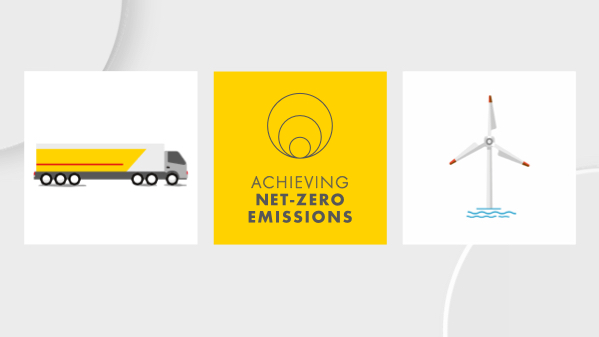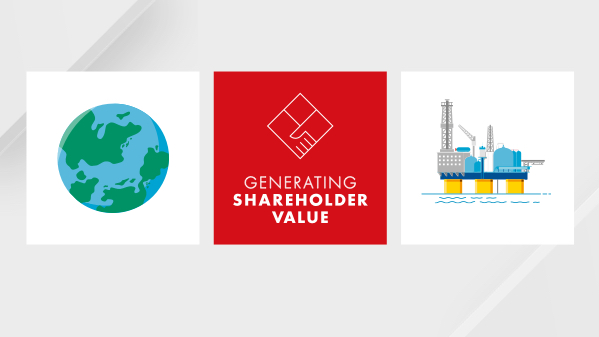Greenhouse gas and energy data
|
Unit |
2021 |
2020 |
2019 |
2018 |
2017 |
|
IPIECA |
SASB |
GRI |
||||||||||||||
|---|---|---|---|---|---|---|---|---|---|---|---|---|---|---|---|---|---|---|---|---|---|---|---|---|
NET CARBON INTENSITY [A] [D] |
|
|
|
|
|
|
|
|
|
|
||||||||||||||
Net carbon intensity |
gCO2e/MJ |
77 |
75 |
78 |
79 |
79 |
|
– |
– |
– |
||||||||||||||
Estimated total energy delivered by Shell |
trillion (10^12) MJ |
17.89 |
18.40 |
21.05 |
22.00 |
21.44 |
|
– |
– |
– |
||||||||||||||
Share of energy delivered per energy product type [B] [E] |
|
|
|
|
|
|
|
|
|
|
||||||||||||||
Oil products and GTL |
% |
45 |
47 |
56 |
55 |
54 |
|
– |
– |
– |
||||||||||||||
Gas |
% |
25 |
21 |
17 |
21 |
23 |
|
– |
– |
– |
||||||||||||||
LNG |
% |
18 |
19 |
18 |
16 |
15 |
|
– |
– |
– |
||||||||||||||
Biofuels |
% |
1 |
1 |
1 |
1 |
1 |
|
– |
– |
– |
||||||||||||||
Power |
% |
12 |
12 |
9 |
7 |
7 |
|
– |
– |
– |
||||||||||||||
Total estimated greenhouse gas emissions covered by the net carbon intensity calculation [C] |
million tonnes CO2e |
1,375 |
1,384 |
1,646 |
1,731 |
1,688 |
|
– |
– |
– |
||||||||||||||
Carbon intensity of energy products type [F] [G] |
|
|
|
|
|
|
|
|
|
|
||||||||||||||
Oil products and GTL |
gCO2e/MJ |
91 |
89 |
89 |
88 |
89 |
|
– |
– |
– |
||||||||||||||
Gas |
gCO2e/MJ |
66 |
67 |
66 |
67 |
67 |
|
– |
– |
– |
||||||||||||||
LNG |
gCO2e/MJ |
70 |
70 |
71 |
71 |
71 |
|
– |
– |
– |
||||||||||||||
Biofuels |
gCO2e/MJ |
41 |
38 |
39 |
37 |
39 |
|
– |
– |
– |
||||||||||||||
Power |
gCO2e/MJ |
66 |
48 |
57 |
62 |
60 |
|
– |
– |
– |
||||||||||||||
|
||||||||||||||||||||||||
|
Unit |
2021 |
2020 |
2019 [A] |
2018 |
2017 |
|
IPIECA |
SASB |
GRI |
||||
|---|---|---|---|---|---|---|---|---|---|---|---|---|---|---|
Gas |
tBtu |
3,630 |
3,009 |
2,720 |
3,246 |
3,276 |
|
– |
– |
– |
||||
Power |
TWh |
247 |
252 |
207 |
179 |
165 |
|
– |
– |
– |
||||
|
||||||||||||||
|
Unit |
2021 |
2020 |
2019 |
2018 |
2017 |
|
IPIECA |
SASB |
GRI |
||||||||||||||||||||||
|---|---|---|---|---|---|---|---|---|---|---|---|---|---|---|---|---|---|---|---|---|---|---|---|---|---|---|---|---|---|---|---|---|
Direct GHG emissions (Scope 1) |
million tonnes CO2e |
60 |
63 |
70 |
71 |
73 |
|
|||||||||||||||||||||||||
Carbon dioxide (CO2) |
million tonnes |
58 |
61 |
67 |
69 |
70 |
|
CCE-4 |
EM-EP-110a.1 |
305-1 |
||||||||||||||||||||||
Methane (CH4) |
thousand tonnes |
55 |
67 |
91 |
92 |
123 |
|
CCE-4 |
EM-EP-110a.1 |
305-1 |
||||||||||||||||||||||
Nitrous oxide (N2O) |
thousand tonnes |
1 |
1 |
1 |
1 |
1 |
|
CCE-4 |
EM-EP-110a.1 |
305-1 |
||||||||||||||||||||||
Hydrofluorocarbons (HFCs) |
tonnes |
25 |
30 |
29 |
31 |
22 |
|
CCE-4 |
EM-EP-110a.1 |
305-1 |
||||||||||||||||||||||
Sulphur hexafluoride (SF6) |
tonnes |
0.01 |
0.01 |
0.01 |
0.03 |
0.01 |
|
CCE-4 |
EM-EP-110a.1 |
305-1 |
||||||||||||||||||||||
Perfluorocarbons (PFC) |
tonnes |
0 |
0 |
0 |
0 |
0 |
|
CCE-4 |
EM-EP-110a.1 |
305-1 |
||||||||||||||||||||||
Nitrogen trifluoride (NF3) |
tonnes |
0 |
0 |
0 |
0 |
0 |
|
CCE-4 |
EM-EP-110a.1 |
305-1 |
||||||||||||||||||||||
Scope 1 emissions by business |
|
|
|
|
|
|
|
|
|
|
||||||||||||||||||||||
Upstream |
million tonnes CO2e |
11.7 |
12.8 |
12.9 |
14.8 |
19.6 |
|
CCE-4 |
EM-EP-110a.1 |
305-1 |
||||||||||||||||||||||
Integrated Gas |
million tonnes CO2e |
15.5 |
14.1 |
16.3 |
13.0 |
12.0 |
|
CCE-4 |
EM-EP-110a.1 |
305-1 |
||||||||||||||||||||||
Downstream |
million tonnes CO2e |
32.6 |
35.8 |
40.2 |
42.7 |
41.1 |
|
CCE-4 |
EM-EP-110a.1 |
305-1 |
||||||||||||||||||||||
Refining [E] |
million tonnes CO2e |
20.1 |
23.4 |
28.0 |
29.1 |
27.8 |
|
CCE-4 |
EM-EP-110a.1 |
305-1 |
||||||||||||||||||||||
Chemicals |
million tonnes CO2e |
11.0 |
10.8 |
10.5 |
11.6 |
11.4 |
|
CCE-4 |
EM-EP-110a.1 |
305-1 |
||||||||||||||||||||||
Other Downstream [F] |
million tonnes CO2e |
1.4 |
1.6 |
1.8 |
2.1 |
2.0 |
|
CCE-4 |
EM-EP-110a.1 |
305-1 |
||||||||||||||||||||||
Other [G] |
million tonnes CO2e |
0.2 |
0.2 |
0.2 |
0.8 |
0.2 |
|
CCE-4 |
EM-EP-110a.1 |
305-1 |
||||||||||||||||||||||
Scope 1 emissions by country |
|
|
|
|
|
|
|
|
|
|
||||||||||||||||||||||
USA |
million tonnes CO2e |
13 |
16 |
19 |
20 |
18 |
|
CCE-4 |
EM-EP-110a.1 |
305-1 |
||||||||||||||||||||||
Middle East |
million tonnes CO2e |
9 |
9 |
9 |
10 |
11 |
|
CCE-4 |
EM-EP-110a.1 |
305-1 |
||||||||||||||||||||||
Netherlands |
million tonnes CO2e |
7 |
7 |
7 |
7 |
7 |
|
CCE-4 |
EM-EP-110a.1 |
305-1 |
||||||||||||||||||||||
Singapore |
million tonnes CO2e |
5 |
6 |
6 |
7 |
7 |
|
CCE-4 |
EM-EP-110a.1 |
305-1 |
||||||||||||||||||||||
Australia |
million tonnes CO2e |
5 |
4 |
7 |
4 |
3 |
|
CCE-4 |
EM-EP-110a.1 |
305-1 |
||||||||||||||||||||||
Canada |
million tonnes CO2e |
5 |
5 |
6 |
6 |
6 |
|
CCE-4 |
EM-EP-110a.1 |
305-1 |
||||||||||||||||||||||
Nigeria |
million tonnes CO2e |
5 |
5 |
4 |
4 |
5 |
|
CCE-4 |
EM-EP-110a.1 |
305-1 |
||||||||||||||||||||||
Germany |
million tonnes CO2e |
3 |
3 |
3 |
4 |
4 |
|
CCE-4 |
EM-EP-110a.1 |
305-1 |
||||||||||||||||||||||
Malaysia |
million tonnes CO2e |
2 |
3 |
2 |
3 |
3 |
|
CCE-4 |
EM-EP-110a.1 |
305-1 |
||||||||||||||||||||||
United Kingdom |
million tonnes CO2e |
2 |
2 |
2 |
2 |
3 |
|
CCE-4 |
EM-EP-110a.1 |
305-1 |
||||||||||||||||||||||
International waters |
million tonnes CO2e |
1 |
1 |
2 |
2 |
1 |
|
CCE-4 |
EM-EP-110a.1 |
305-1 |
||||||||||||||||||||||
Rest of the world |
million tonnes CO2e |
2 |
3 |
3 |
4 |
5 |
|
CCE-4 |
EM-EP-110a.1 |
305-1 |
||||||||||||||||||||||
Scope 1 emissions by source |
|
|
|
|
|
|
|
|
|
|
||||||||||||||||||||||
CO2 emissions |
million tonnes |
58 |
61 |
67 |
69 |
70 |
|
CCE-4 |
EM-EP-110a.2 |
305-1 |
||||||||||||||||||||||
Combustion |
million tonnes |
47 |
50 |
53 |
54 |
53 |
|
CCE-4 |
EM-EP-110a.2 |
305-1 |
||||||||||||||||||||||
Flaring |
million tonnes |
5 |
4 |
7 |
6 |
9 |
|
CCE-4 |
EM-EP-110a.2 |
305-1 |
||||||||||||||||||||||
Venting and process |
million tonnes |
6 |
6 |
8 |
9 |
8 |
|
CCE-4 |
EM-EP-110a.2 |
305-1 |
||||||||||||||||||||||
Fugitives |
million tonnes |
0 |
0 |
0 |
0 |
0 |
|
CCE-4 |
EM-EP-110a.2 |
305-1 |
||||||||||||||||||||||
CH4 emissions |
thousand tonnes |
55 |
67 |
91 |
92 |
123 |
|
CCE-4 |
EM-EP-110a.2 |
305-1 |
||||||||||||||||||||||
Combustion |
thousand tonnes |
7 |
11 |
13 |
13 |
12 |
|
CCE-4 |
EM-EP-110a.2 |
305-1 |
||||||||||||||||||||||
Flaring |
thousand tonnes |
19 |
15 |
19 |
18 |
27 |
|
CCE-4 |
EM-EP-110a.2 |
305-1 |
||||||||||||||||||||||
Venting and process |
thousand tonnes |
22 |
29 |
44 |
45 |
62 |
|
CCE-4 |
EM-EP-110a.2 |
305-1 |
||||||||||||||||||||||
Fugitives |
thousand tonnes |
7 |
12 |
15 |
16 |
23 |
|
CCE-4 |
EM-EP-110a.2 |
305-1 |
||||||||||||||||||||||
Other greenhouse gases |
million tonnes CO2e |
0.2 |
0.3 |
0.3 |
0.3 |
0.3 |
|
CCE-4 |
EM-EP-110a.2 |
305-1 |
||||||||||||||||||||||
Methane (CH4) emissions |
|
|
|
|
|
|
|
|
|
|
||||||||||||||||||||||
Methane emissions in CO2 equivalent [H] |
million tonnes CO2e |
1.4 |
1.7 |
2.3 |
2.3 |
3.1 |
|
CCE-4 |
EM-EP-110a.1 |
305-1 |
||||||||||||||||||||||
Methane emissions intensity - assets with marketed gas |
% |
0.06 |
0.06 |
0.08 |
0.08 |
– |
|
CCE-4 |
EM-EP-110a.1 |
305-1 |
||||||||||||||||||||||
Methane emissions intensity - assets without marketed gas |
% |
0.01 |
0.01 |
0.01 |
0.01 |
– |
|
CCE-4 |
EM-EP-110a.1 |
305-1 |
||||||||||||||||||||||
Upstream flaring [I] |
|
|
|
|
|
|
|
|
|
|
||||||||||||||||||||||
GHG emissions from flaring |
million tonnes CO2e |
4.5 |
3.8 |
5.9 |
5.2 |
8.2 |
|
CCE-4 |
EM-EP-110a.2 |
305-1 |
||||||||||||||||||||||
Total hydrocarbons flared |
million tonnes |
1.3 |
1.1 |
1.8 |
1.5 |
2.5 |
|
CCE-4 |
EM-EP-110a.2 |
305-1 |
||||||||||||||||||||||
Nigeria |
million tonnes |
0.8 |
0.6 |
0.7 |
0.6 |
0.8 |
|
CCE-4 |
EM-EP-110a.2 |
305-1 |
||||||||||||||||||||||
Rest of the world |
million tonnes |
0.4 |
0.5 |
1.2 |
1.0 |
1.7 |
|
CCE-4 |
EM-EP-110a.2 |
305-1 |
||||||||||||||||||||||
Total hydrocarbons flared - routine |
million tonnes |
0.2 |
0.3 |
0.5 |
0.6 |
1.2 |
|
– |
– |
– |
||||||||||||||||||||||
Total hydrocarbons flared - non-routine |
million tonnes |
1.0 |
0.8 |
1.4 |
0.9 |
1.3 |
|
– |
– |
– |
||||||||||||||||||||||
Upstream Flaring Intensity [J] |
% |
0.8 |
0.6 |
0.9 |
0.8 |
1.1 |
|
– |
– |
– |
||||||||||||||||||||||
GHG emissions from exported energy [K] |
million tonnes CO2e |
3 |
3 |
3 |
3 |
3 |
|
CCE-4 |
EM-EP-110a.2 |
305-1 |
||||||||||||||||||||||
|
||||||||||||||||||||||||||||||||
|
Unit |
2021 |
2020 |
2019 |
2018 |
2017 |
|
IPIECA |
SASB |
GRI |
||||||
|---|---|---|---|---|---|---|---|---|---|---|---|---|---|---|---|---|
Scope 2 emissions - market-based method |
million tonnes CO2e |
8 |
8 |
10 |
11 |
12 |
|
|||||||||
Scope 2 emissions - location-based method |
million tonnes CO2e |
9 |
10 |
11 |
11 |
11 |
|
CCE-4 |
– |
305-2 |
||||||
Scope 2 emissions by business (market-based method) |
|
|
|
|
|
|
|
|
|
|
||||||
Upstream |
million tonnes CO2e |
0.6 |
0.6 |
1.1 |
1.4 |
1.4 |
|
CCE-4 |
– |
305-2 |
||||||
Integrated Gas |
million tonnes CO2e |
1.4 |
1.5 |
1.6 |
2.4 |
2.4 |
|
CCE-4 |
– |
305-2 |
||||||
Downstream |
million tonnes CO2e |
5.6 |
6.0 |
6.9 |
6.8 |
7.5 |
|
CCE-4 |
– |
305-2 |
||||||
Other |
million tonnes CO2e |
0.1 |
0.1 |
0.2 |
0.2 |
0.2 |
|
CCE-4 |
– |
305-2 |
||||||
Scope 2 emissions by country (market-based method) |
|
|
|
|
|
|
|
|
|
|
||||||
USA |
million tonnes CO2e |
2.6 |
3.0 |
3.1 |
3.2 |
3.1 |
|
CCE-4 |
– |
305-2 |
||||||
Netherlands |
million tonnes CO2e |
1.5 |
1.4 |
1.7 |
1.8 |
1.9 |
|
CCE-4 |
– |
305-2 |
||||||
Australia |
million tonnes CO2e |
1.3 |
1.4 |
1.6 |
2.4 |
2.3 |
|
CCE-4 |
– |
305-2 |
||||||
Canada |
million tonnes CO2e |
1.2 |
1.3 |
2.3 |
2.0 |
2.7 |
|
CCE-4 |
– |
305-2 |
||||||
Singapore |
million tonnes CO2e |
0.5 |
0.5 |
0.5 |
0.5 |
0.6 |
|
CCE-4 |
– |
305-2 |
||||||
Germany |
million tonnes CO2e |
0.2 |
0.3 |
0.3 |
0.4 |
0.7 |
|
CCE-4 |
– |
305-2 |
||||||
Rest of the world |
million tonnes CO2e |
0.2 |
0.2 |
0.3 |
0.4 |
0.3 |
|
CCE-4 |
– |
305-2 |
||||||
Scope 2 emissions by business (location-based method) |
|
|
|
|
|
|
|
|
|
|
||||||
Upstream |
million tonnes CO2e |
0.6 |
0.6 |
1.1 |
1.2 |
1.4 |
|
CCE-4 |
– |
305-2 |
||||||
Integrated Gas |
million tonnes CO2e |
2.6 |
2.7 |
2.7 |
2.4 |
2.3 |
|
CCE-4 |
– |
305-2 |
||||||
Downstream |
million tonnes CO2e |
5.5 |
6.1 |
7.1 |
6.8 |
7.4 |
|
CCE-4 |
– |
305-2 |
||||||
Other |
million tonnes CO2e |
0.1 |
0.2 |
0.2 |
0.2 |
0.2 |
|
CCE-4 |
– |
305-2 |
||||||
Scope 2 emissions by country (location-based method) |
|
|
|
|
|
|
|
|
|
|
||||||
USA |
million tonnes CO2e |
2.6 |
3.1 |
3.2 |
3.4 |
3.1 |
|
CCE-4 |
– |
305-2 |
||||||
Australia |
million tonnes CO2e |
2.5 |
2.6 |
2.6 |
2.4 |
2.3 |
|
CCE-4 |
– |
305-2 |
||||||
Netherlands |
million tonnes CO2e |
1.4 |
1.3 |
1.6 |
1.7 |
1.9 |
|
CCE-4 |
– |
305-2 |
||||||
Canada |
million tonnes CO2e |
1.2 |
1.4 |
2.3 |
2.0 |
2.7 |
|
CCE-4 |
– |
305-2 |
||||||
Singapore |
million tonnes CO2e |
0.5 |
0.5 |
0.5 |
0.5 |
0.6 |
|
CCE-4 |
– |
305-2 |
||||||
Germany |
million tonnes CO2e |
0.2 |
0.3 |
0.4 |
0.3 |
0.4 |
|
CCE-4 |
– |
305-2 |
||||||
Rest of the world |
million tonnes CO2e |
0.3 |
0.4 |
0.4 |
0.4 |
0.3 |
|
CCE-4 |
– |
305-2 |
||||||
|
||||||||||||||||
|
Unit |
2021 |
2020 |
2019 |
2018 |
2017 |
|
IPIECA |
SASB |
GRI |
||||||||
|---|---|---|---|---|---|---|---|---|---|---|---|---|---|---|---|---|---|---|
Upstream and Integrated Gas GHG intensity [A] |
tonne CO2e/tonne production |
0.172 |
0.159 |
0.168 |
0.158 |
0.166 |
|
|||||||||||
Upstream and Integrated Gas GHG intensity [B] |
kg CO2e/boe |
22 |
21 |
22 |
21 |
22 |
|
CCE-4 |
– |
305-4 |
||||||||
Refinery GHG intensity [C] |
tonne CO2e/UEDCTM |
1.05 |
1.05 |
1.06 |
1.05 |
1.14 |
|
CCE-4 |
– |
305-4 |
||||||||
Chemical GHG intensity [D] |
tonne CO2e/tonne production |
0.95 |
0.98 |
1.04 |
0.96 |
0.95 |
|
CCE-4 |
– |
305-4 |
||||||||
|
||||||||||||||||||
|
Unit |
2021 |
2020 |
2019 |
2018 |
2017 |
|
IPIECA |
SASB |
GRI |
||
|---|---|---|---|---|---|---|---|---|---|---|---|---|
Direct GHG emissions (Scope 1) |
million tonnes CO2e |
91 |
98 |
105 |
102 |
97 |
|
|||||
Upstream |
million tonnes CO2e |
18.5 |
20.1 |
21.7 |
22.2 |
25.4 |
|
CCE-4 |
EM-EP-110a.1 |
305-1 |
||
Integrated Gas |
million tonnes CO2e |
24.5 |
24.2 |
25.9 |
25.2 |
24.1 |
|
CCE-4 |
EM-EP-110a.1 |
305-1 |
||
Downstream |
million tonnes CO2e |
47.6 |
53.2 |
57.3 |
53.8 |
47.1 |
|
CCE-4 |
EM-EP-110a.1 |
305-1 |
||
Other |
million tonnes CO2e |
0.2 |
0.2 |
0.2 |
0.8 |
0.3 |
|
CCE-4 |
EM-EP-110a.1 |
305-1 |
||
Scope 2 emissions (market-based method) |
million tonnes CO2e |
9 |
9 |
11 |
11 |
13 |
|
CCE-4 |
– |
305-2 |
||
Upstream |
million tonnes CO2e |
0.7 |
0.7 |
1.2 |
1.3 |
1.3 |
|
CCE-4 |
– |
305-2 |
||
Integrated Gas |
million tonnes CO2e |
1.1 |
1.0 |
1.1 |
1.8 |
2.0 |
|
CCE-4 |
– |
305-2 |
||
Downstream |
million tonnes CO2e |
6.7 |
7.1 |
8.0 |
7.7 |
9.2 |
|
CCE-4 |
– |
305-2 |
||
Other |
million tonnes CO2e |
0.1 |
0.1 |
0.2 |
0.2 |
0.2 |
|
CCE-4 |
– |
305-2 |
||
Scope 2 emissions (location-based method) |
million tonnes CO2e |
10 |
10 |
12 |
11 |
13 |
|
– |
– |
– |
||
Upstream |
million tonnes CO2e |
0.7 |
0.8 |
1.2 |
1.2 |
1.3 |
|
CCE-4 |
– |
305-2 |
||
Integrated Gas |
million tonnes CO2e |
1.8 |
1.7 |
1.8 |
1.8 |
2.0 |
|
CCE-4 |
– |
305-2 |
||
Downstream |
million tonnes CO2e |
7.0 |
7.5 |
8.3 |
7.6 |
9.5 |
|
CCE-4 |
– |
305-2 |
||
Other |
million tonnes CO2e |
0.1 |
0.2 |
0.2 |
0.3 |
0.2 |
|
CCE-4 |
– |
305-2 |
||
|
||||||||||||
|
Unit |
2021 |
2020 |
2019 |
2018 |
2017 |
|
IPIECA |
SASB |
GRI |
||||||||||||||||
|---|---|---|---|---|---|---|---|---|---|---|---|---|---|---|---|---|---|---|---|---|---|---|---|---|---|---|
Purchased goods and services (Category 1) |
|
|
|
|
|
|
|
|
|
|
||||||||||||||||
Third-party products [C] |
million tonnes CO2e |
147 |
147 |
178 |
190 |
186 |
|
CCE-4 |
– |
305-3 |
||||||||||||||||
Fuel and energy-related activities (not included in Scope 1 or Scope 2) (Category 3) |
|
|
|
|
|
|
|
|
|
|
||||||||||||||||
Third-party power [D] |
million tonnes CO2e |
136 |
103 |
102 |
96 |
87 |
|
CCE-4 |
– |
305-3 |
||||||||||||||||
Downstream Transportation and Distribution (Category 9) |
|
|
|
|
|
|
|
|
|
|
||||||||||||||||
Sold own energy products [E] |
million tonnes CO2e |
6 |
– |
– |
– |
– |
|
– |
– |
305-3 |
||||||||||||||||
Use of sold products (Category 11) |
|
|
|
|
|
|
|
|
|
|
||||||||||||||||
Use of sold products [F] |
million tonnes CO2e |
1,010 |
1,054 |
1,271 |
1,351 |
1,318 |
|
CCE-4 |
– |
305-3 |
||||||||||||||||
Own production [G] |
million tonnes CO2e |
380 |
452 |
564 |
594 |
582 |
|
– |
||||||||||||||||||
Third-party products [H] |
million tonnes CO2e |
630 |
602 |
708 |
757 |
736 |
|
CCE-4 |
– |
305-3 |
||||||||||||||||
|
||||||||||||||||||||||||||
|
Unit |
2021 |
2020 |
2019 |
2018 |
2017 |
|
IPIECA |
SASB |
GRI |
||||
|---|---|---|---|---|---|---|---|---|---|---|---|---|---|---|
Carbon capture and storage and CO2 transfer out |
|
|
|
|
|
|
|
|
|
|
||||
CO2 captured and stored |
million tonnes |
1.05 |
0.94 |
1.13 |
1.07 |
1.14 |
|
|||||||
CO2 transferred out [A] |
million tonnes |
0.33 |
0.30 |
0.43 |
0.46 |
0.45 |
|
EM-EP-530a.1 |
305-5 |
|||||
Biogenic CO2 |
|
|
|
|
|
|
|
|
|
|
||||
Biogenic CO2 [B] |
thousand tonnes |
3.60 |
0.27 |
0.00 |
0.00 |
9.70 |
|
– |
– |
– |
||||
|
||||||||||||||
|
Unit |
2021 |
2020 |
2019 |
2018 |
2017 |
|
IPIECA |
SASB |
GRI |
||
|---|---|---|---|---|---|---|---|---|---|---|---|---|
Total carbon credits retired |
|
|
|
|
|
|
|
|
|
|
||
Included in net carbon intensity |
million tonnes |
5.1 |
3.9 |
2.2 |
0.0 |
0.0 |
|
– |
||||
Other carbon credits |
million tonnes |
1.3 |
0.4 |
0.5 |
n/c |
n/c |
|
– |
EM-EP-530a.1 |
305-5 |
||
|
||||||||||||
|
Unit |
2021 |
2020 |
2019 |
2018 |
2017 |
|
IPIECA |
SASB |
GRI |
||||||
|---|---|---|---|---|---|---|---|---|---|---|---|---|---|---|---|---|
Total energy use |
million MWh |
223 |
241 |
264 |
268 |
269 |
|
|||||||||
Own energy generated |
million MWh |
202 |
219 |
236 |
240 |
241 |
|
CCE-6 |
– |
302-1 |
||||||
Imported electricity |
million MWh |
20 |
22 |
27 |
26 |
26 |
|
CCE-6 |
– |
302-1 |
||||||
Imported steam and heat |
million MWh |
14 |
14 |
17 |
15 |
17 |
|
CCE-6 |
– |
302-1 |
||||||
Exported electricity |
million MWh |
11 |
12 |
10 |
10 |
10 |
|
CCE-6 |
– |
302-1 |
||||||
Exported steam and heat |
million MWh |
2 |
2 |
6 |
3 |
5 |
|
CCE-6 |
– |
302-1 |
||||||
Consumption of energy from renewable sources |
|
|
|
|
|
|
|
|
|
|
||||||
Renewable sources - onsite energy generation consumed |
million MWh |
0.004 |
0.005 |
n/c |
n/c |
n/c |
|
CCE-6 |
– |
302-1 |
||||||
Renewable sources - purchased electricity |
million MWh |
2.1 |
1.8 |
1.5 |
0.03 |
0.03 |
|
CCE-6 |
– |
302-1 |
||||||
Renewable sources - purchased steam |
million MWh |
0.00 |
0.00 |
n/c |
n/c |
n/c |
|
CCE-6 |
– |
302-1 |
||||||
Renewable sources - electricity exported to grid |
million MWh |
0.5 |
0.4 |
0.4 |
n/c |
n/c |
|
CCE-6 |
– |
302-1 |
||||||
Energy intensity |
|
|
|
|
|
|
|
|
|
|
||||||
Upstream excl. oil sands, LNG and GTL |
GJ/ |
1.14 |
1.15 |
1.07 |
1.06 |
1.05 |
|
CCE-6 |
– |
302-1 |
||||||
Refineries: Refinery Energy Index [B] |
Index |
96.9 |
96.1 |
94.2 |
94.3 |
94.8 |
|
CCE-6 |
– |
302-1 |
||||||
Chemical plants: chemicals energy intensity |
GJ/ |
18.1 |
18.7 |
19.4 |
18.3 |
17.6 |
|
CCE-6 |
– |
302-1 |
||||||
|
||||||||||||||||









